Carlie Owen, MEL Candidate | December 16, 2020
APPP 506 – Master of Engineering Leadership Capstone Project, University of British Columbia
Abstract
Since 1950, 79% or approximately 6.6 billion tonnes of plastic has been landfilled or ended up in the environment [1]. This plastic will not biodegrade for hundreds of years. To help reduce the dependency on fossil fuels and aid in plastic waste reductions, bioplastics have emerged as an alternative material. While only making up 1% of the global plastics market, companies producing bioplastic are cropping up around the world [2]. Bioplastics have the potential to be circular but key questions exist when determining if the deployment of bioplastic is meeting this potential. Are producers designing out waste? Do consumers understand how to correctly dispose of these product alternatives? What waste management options exist today and in the future?
Creating circular economies are necessary to reduce waste on our planet, but with all of the players in the supply chain working in silos, the product ecosystem is falling short. There is a lack of communication amongst stakeholders in the North American supply chain, and few regulatory frameworks exist to dictate best practices. As such, a North American forum must be created to break the barriers of communication. The economy is global. In the future, tying in supply chain members from overseas could be a benefit to effectively round the corner and achieve bioplastic circularity.
Background
Biomaterials and Bioplastics
Since 1950, 8.3 billion tonnes of plastic has been produced [1]. Currently, only 9% of that plastic is recycled and 12% incinerated, leaving 79% or approximately 6.6 billion tonnes of plastic ending up in landfills or the environment [1]. The waste generated from the plastics industry is of paramount importance because it can take hundreds of years for plastic to break down [3]. It is common for the plastic to not fully decompose, but instead become small microplastic particles which accumulate, negatively impacting ecosystems [3]. The reuse, reduce, recycle movement has brought a degree of awareness surrounding human waste concerns, while innovative technologies are being created to replace fossil-based plastics all together. Bio-based materials, made from biological feedstocks like sugar cane or corn, present a potential answer to the call for a more sustainable future. The focus of this study is on a subsection of these materials, bioplastics. While bioplastics have been around since the 1930s, pre-dating many fossil fuel derived plastics, the expansion of the bioplastics market started in the 1990s and is expected to grow by 13% over the next four years [4,5]. Bioplastics and bio-based materials as a whole, are a way for society to shift from a fossil-fuel based society to a biological based society, thereby reducing the human carbon footprint.
Circular Economy for Bioplastics
Biomaterials are created with the intention of being circular, however there lies a gap in understanding in how to effectively manage end-of-life (EoL) for biomaterials. For the context of this work, end-of-life can be described as the step in the supply chain after consumer use, also known as the time of disposal. The concept of a circular economy, is described by a product re-entering an economic supply chain post end-of-life. Figure 1 below, describes an ideal circular economy for a biomaterial.
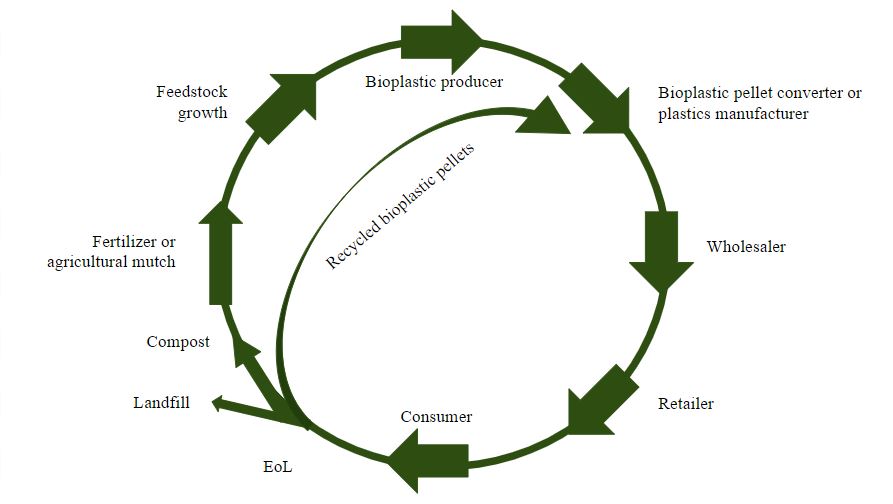
Literature regarding EoL of biomaterials typically include analysis of the collection and conversion of waste streams as well as the availability of secondary material markets [6]. Other works delve into the full life cycle analysis (LCA) and environmental impact of mismanaged waste, which is beyond the scope of this project.
Beginning-Of-Life Considerations
The beginning-of-life (BoL) of a product is largely focused on the feedstock of choice and the process by which that feedstock is used to create a product. Biomaterials use a biological feedstock or a mix of biological and traditional fossil-based feedstock at the BoL. To promote the circular economy, BoL should be defined by the circularity considerations to include product design, development and production ensuring that the material continues to flow in the economy.
Although there is a certified criterion for determining the carbon content of a biomaterial, there is not a market definition for what can be considered a biomaterial, nor a regulation for how they are to be disposed of [7]. This leads to consumer confusion and greenwashing surrounding these materials.
End-Of-Life Considerations
End-of-life options for plastics and other materials include mechanical and chemical recycling, organic recovery, and energy recovery as detailed in Figure 2 [8]. Mechanical and chemical recycling of bio-based materials is contingent upon being discarded into the correct waste stream and the ability to be recycled. PLA for example can be recycled and returned to a lactic acid feedstock for further polylactic acid (PLA) production [9]. Alternatively, PLA can have the EoL option of organic recovery through composting or energy recovery through anaerobic digestion if the facility is equipped to handle bio-based materials.
Bioplastics have the potential to have a preferred life cycle emissions score to that of traditional plastics if they are disposed of correctly. If left in a landfill or uncontained in the environment, it cannot be definitively said that bio-based materials are the superior alternative from an EoL perspective. Bio-based materials that end up in landfills will decompose and emit CH4. Fossil-based plastics take substantially longer to breakdown, but along the life cycle contribute CO2 emissions which are less impactful when compared to CH4 [10]. This is a common argument against bio-based materials posed by the traditional plastics and fossil fuels industry.
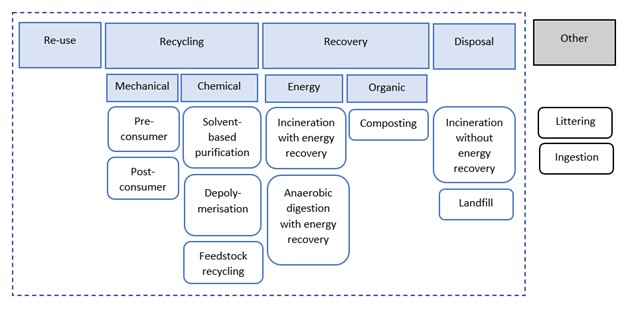
Bioplastics can be segmented based on their feedstock and further by their EoL, that is what they are made from and where they end up. Figure 3 summarizes the types of bioplastics currently on the market and their EoL options. It is important to understand the category a given bioplastic falls into because a bioplastics make-up largely dictates the product’s end-of-life route(s). Bio-based products may be a mixture of biological material and fossil-based materials. This mixture presents a conflict of perception. The user is led to believe the plastic is a more environmentally sound alternative. Thus, the focus is on BoL instead of the EoL decision which is the root of the waste problem. Adding to this complexity, not all bio-based materials have the ability to break down through bacterial decomposition and the ones which do, need to be exposed to the correct environmental conditions: temperature, humidity, aeration, acidity [10]. The lack of understanding of a materials composition and associated EoL alternative, adds to consumer confusion around proper disposal. As such, it is imperative to consider the products’ EoL and to broaden public awareness of proper disposal to reduce the environmental impact of bio-based materials.
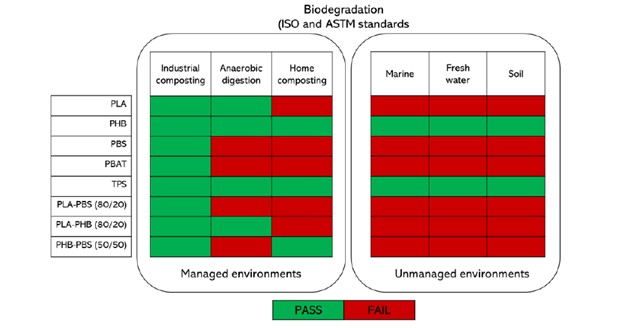
Social and Economic Factors for Bioplastics Circularity
Supply-chain stakeholders, such as bioplastic producers, converters, users, EoL companies and organizations play a vital role in building an effective circular economy. Understanding the thoughts and opinions of each stakeholder allows for adaptation of design and implementation for a more fluid system. Assessing the challenges of each group can inform policy makers to help build a stronger foundation for circularity.
The aforementioned EoL alternatives require individuals to sort their waste effectively and have access to collection services. The process of appropriate sorting can become confusing for the average consumer as only some bioplastics are labeled as such.. A study of 2518 Australians showed that while the perception of bioplastics was high, the understanding of their composition and how to appropriately dispose of them was low [11].These materials require that the consumer be vigilant enough to choose the appropriate waste stream. The lack of clarity has led to discussion about doing away with biomaterials all together. With an understanding of the materials derivation and the potential streams for EoL, an informed consumer may make better decisions that will in turn aid in the abatement of the plastic pollution the world currently faces.
While labels and understanding are key, a deeper dive into the techno-economic benefits of EoL technologies that include energy recovery, composting and recycling in addition to emerging technologies must be conducted in order to validate the biomaterial industry. Essential questions to answer include what technologies exist, what biomaterials qualify, what does the economic benefit look like and how will the public be prompted to access the appropriate waste stream?
Research Methods
- Market analysis to determine major classes of bioplastics and EoL technologies currently on the market place.
A literature review of plastic end of life methodologies and emerging end-of-life technologies (mechanical, chemical, organic recycling, AD, waste incineration, etc.) was conducted. This review included compiling a list of end-of-life technology companies, end-of-life organizations, plastics converters and trading companies as well as bioplastic producers. Over 50 companies were researched and 30 connections were made via LinkedIn or other networking pathways.
- Designing a survey and interviews for different stakeholder groups:
- Bioplastics Producers
- End-of-Life Conversion Technologies
- End-of-Life Organizations
- Bioplastics End-Users
- Other
These stakeholder groups were chosen based on the involvement in the bioplastics supply chain and the direct impact each stakeholder had on end of life. Producers create products, ideally with EoL in mind. Their survey was designed to probe this decision making process.EoL conversion technologies have the potential to transform the waste management landscape. EoL organizations aid in information dissemination and hold substantial knowledge of the current EoL practices like mechanical recycling and composting. The surveys for these stakeholder groups were designed to understand whether bioplastics could fit into their technologies. End-users are allocated the job of sorting the material waste into specific waste streams. The survey for this group was designed to probe their understanding of the requirements for different EoL technologies. Other stakeholders with relevant knowledge included scholars researching the topic, plastics or EoL industry consultants, policy makers or consultants. Alongside the survey, 12 interviews were conducted to allow for a deeper dive into some of the survey questions.
- Thematic analysis of results
Thematic coding was used to convert the qualitative data gathered from the survey and interviews into more substantive quantitative information. The categories that presented themselves after review of the information included:
- Key Drivers
- Supply Chain Mismatches
- Policy Interventions
The survey results and interview notes were compiled, organized by stakeholder category and assessed using the three categories above. Information that pertained to each of the three categories was highlighted in a unique color. The information was then compiled in a logical flow in the report where each category was broken down further into three sub categories: Producers, End-Users, and EoL technologies.
Results
Table 1 below, describes the 21 total survey and interview respondents by their involvement in the bioplastics supply chain. The stakeholder groups include: bioplastics producers, bioplastics converters (those who take plastic feedstock like pellets and convert it into a usable product), EoL technology companies, bioplastics producers who also handle EoL, EoL organizations responsible for information dissemination, and other respondents to include scholars, consultants, policy makers etc.
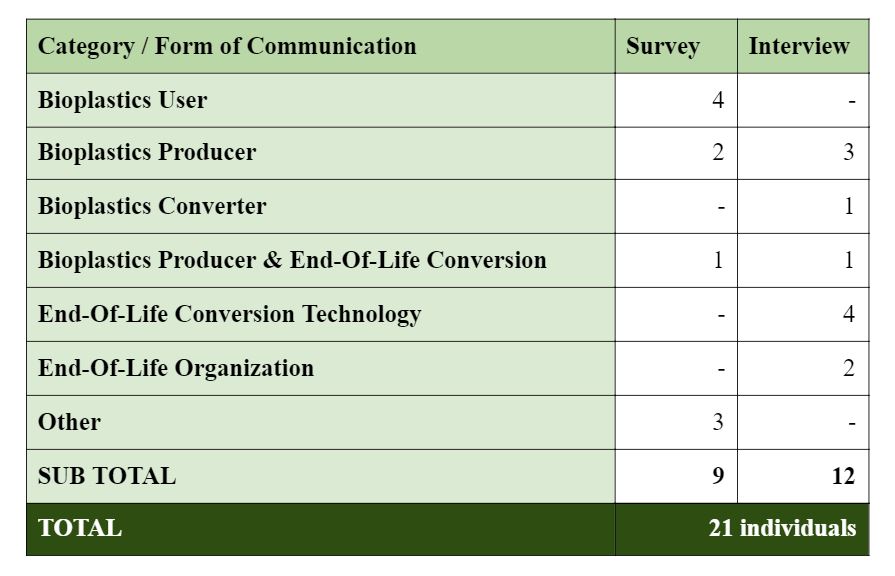
Producers Feedback
Figure 4 below shows the variety of bioplastics that are being introduced to the market.
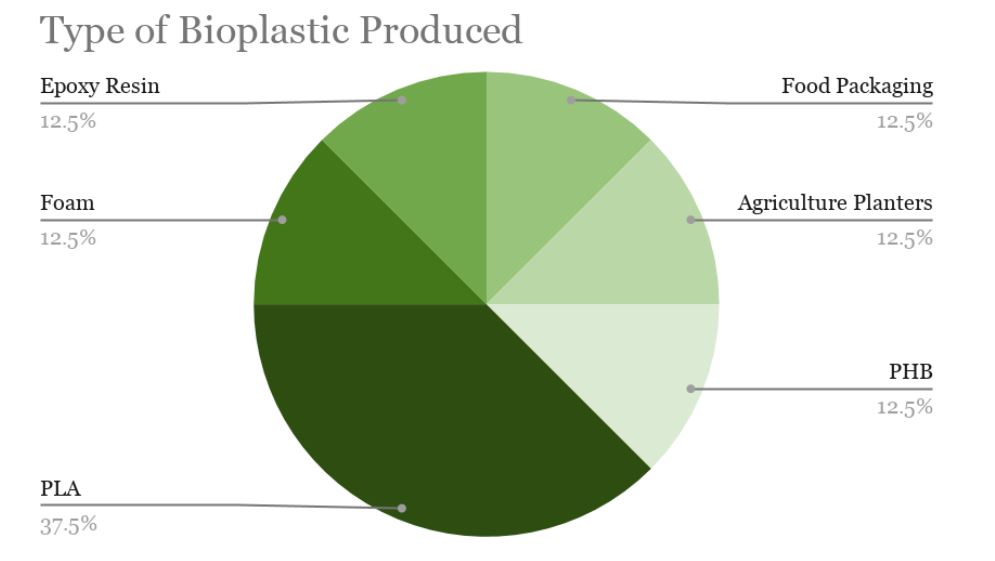
Figure 5 below explains the producers intended end of life alternatives for the products that they produce. Most producers list several end of life alternatives for their bioplastic or none at all.
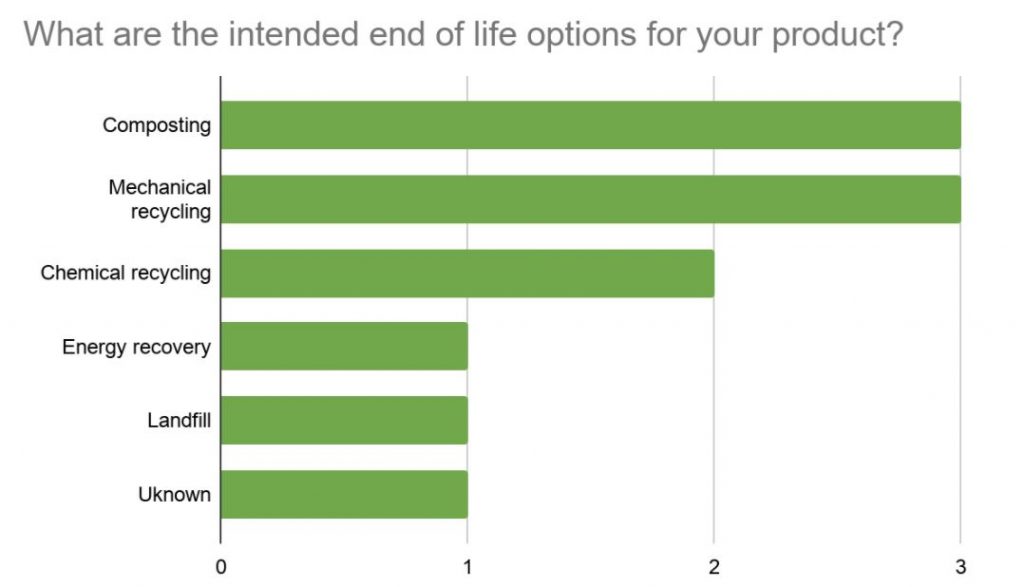
Figure 6 below diagrams respondent’s responses regarding toxicity. The majority of emerging bioplastics producers were still undergoing testing, so official toxicity results were to be determined.
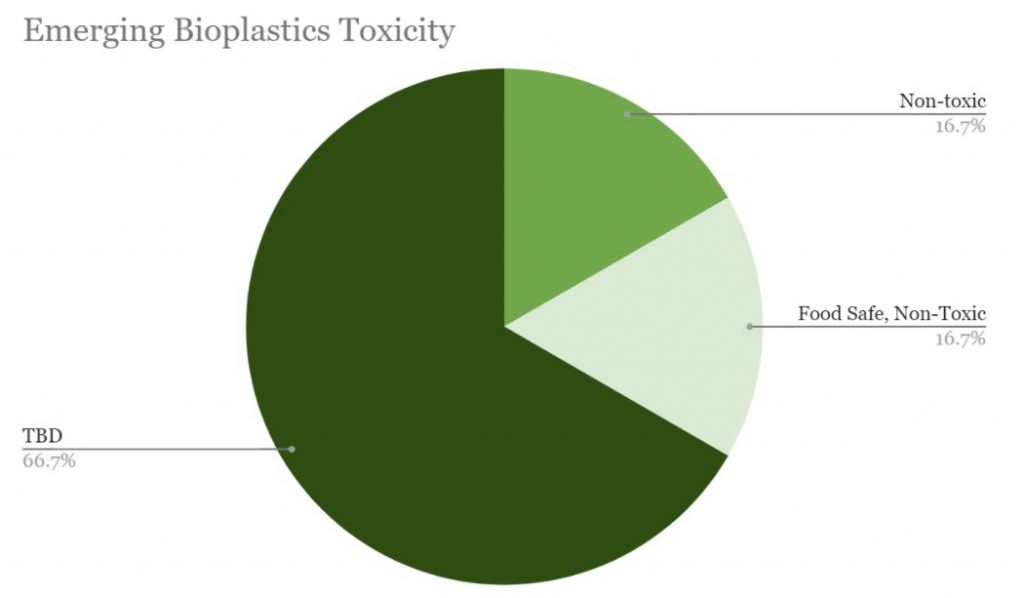
Users Feedback
Four of nine survey respondents were users, indicating that there is an interest in bioplastics and the associated end of use. Figure 7 below, echoes the sentiment that engaged users make a conscious effort to select the appropriate end-of-life alternative.
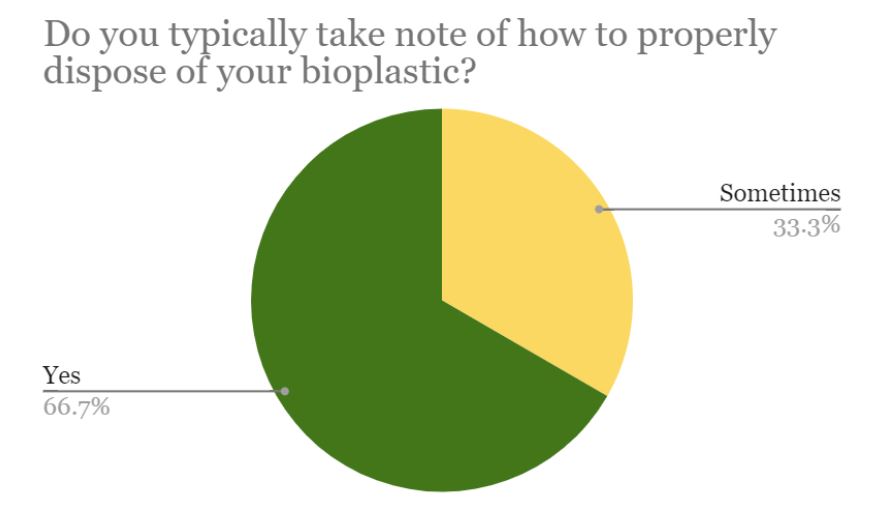
Based on user feedback, it was evident that only about half of users were aware of the type of bioplastic that was used and reported using PLA. While, the remaining 50% of respondents were unsure. This same set of respondents overwhelmingly reported that the typical disposal method was recycling, as seen in Figure 8 below.
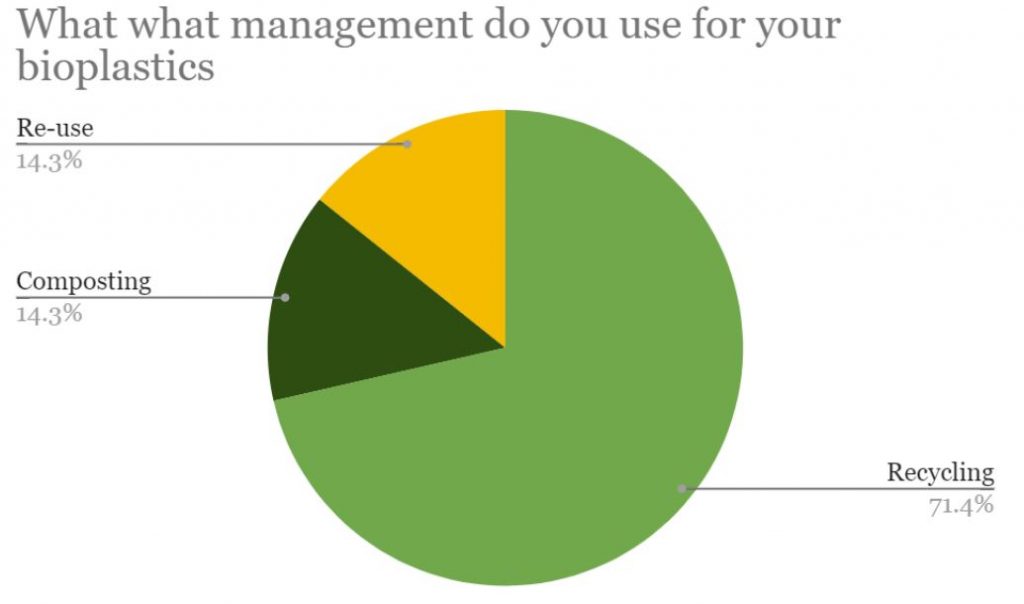
Users unanimously reported that effective labeling would significantly impact their end-of-use decisions. The majority of user respondents also indicated that biodegradability of bioplastics was of high importance.
The information gathered in this investigation, lends itself to where, why and how bioplastics and plastics in general are not making a full-loop in the circular economy. It became evident that a hyper focus on one point in the supply chain, like EoL, was the very problem needing to be addressed. Each player in the supply chain presents distinct perspectives that have been elaborated on in the full version of this report.
Discussion Sneak Peak
Thematic coding was applied to the information gathered from interviews and survey results of various stakeholders in the bioplastics and traditional plastics supply chain. Through the analysis, three categories presented themselves: key drivers for the supply chain members, the apparent supply chain mismatches, and the apparent need for policy interventions. For a full understanding of the findings in this report, please consult the Regenerative Waste Labs team.
Through the series of interviews and survey responses, it is evident that each player in the supply chain desires to make a positive impact on the economy and the climate. However, the North American waste management system is failing. 79% of plastics still end up in the environment. Without a full systematic approach, bioplastics producers alone cannot solve the problem [1]. Bioplastics are fundamentally circular in nature, but working in silos is preventing full circularity from being achieved. The lack of communication, regulation and effective implementation of these materials are why the global economy is failing to round the corner. The advancement of technologies throughout the supply chain must be met with equally as progressive communication and regulatory strategies to effectively build the bio-circular economy and reduce plastic waste.
The findings in this report are a microcosm of the broader waste management infrastructure problem in North America. As the production of bioplastics increases, the concept of full circularity must be of the highest priority in order to tackle the systemic plastic pollution problem.
To Infinity and Beyond
In order to successfully achieve a bioplastics circular economy, several steps must be taken to facilitate communication and collaboration. There is a fundamental breakdown in communication amongst each area in the circular economic supply chain. In North America, producers do not have appropriate funding, guidelines or updated testing criteria to ensure that emerging bioplastics intentionally design out waste and have a strong end-of-life strategy before commercialization. Converters are not mandated to include clear end-of-life labeling on the products produced. Users are not provided with a clear idea of where their products are to be disposed of or what the product is made of. Current end-of-life organizations are incentivized to fully accept bioplastics due to economies of scale and/or certifications that do not meet on site standards. These communication pitfalls are not entirely unique to bioplastics as discussed in the previous section. The North American waste management system needs reframing. To help facilitate both the waste management system refresh and the bio-circular economy, there should be a strategy in place to create first a North American network, the bioplastics circular economy coalition (BCEC). This network can aid in breaking down the silos that the bioplastics industry works in currently.
The Vision: To reduce global plastic waste through a fundamental paradigm shift that focuses on bio-based materials over fossil fuels.
The Mission: To lay the foundation for a strong global bio-material circular economy that reduces emissions, reduces waste and results in infinite benefits.
The Strategy: Starting with a North American forum to create a roundtable platform for emerging bioplastics companies, emerging end-of-life technologies, and informational organizations in conjunction with those existing end-of-life organizations like city recycling and composting facilities as well as policy makers. The creation of the platform will allow for best practice sharing, the understanding of concerns or complications and to inform policy makers as to what is needed to implement an effective waste management system. Overtime, loop in global players as the bioplastics economy is global.
The Goals: To successfully disseminate information throughout the supply chain to the consumer level, such that the consumer is informed, proper waste disposal is made easy, and the consumer is engaged in the process.
Comparative life cycle assessments should be conducted on each type of bioplastic produced to demonstrate how it is superior to its fossil-based counterpart, from a cradle to grave emissions perspective. Financial models should be created to demonstrate how various end-of-life alternatives add value in the circular economy.
Contact
Carlie Elizabeth Owen

carlie.owen@gmail.com
(604) 789 8352
www.linkedin.com/in/carlie-owen333
Acknowledgements
Thank you to Dr. Love Ese Chile for her mentorship and support throughout this capstone. The understanding gained from this project was fundamental to the degree at UBC. It was a joy working alongside the team at Regenerative Waste Labs. The company’s work will continue to shape how the bio-based material industry evolves.
Thank you to the individuals that so graciously provided their time for this project and to those doing the work to improve plastic waste management around the globe. The list of emerging technologies is ever-growing and many aided in shaping the context for this study. The list that follows is not exhaustive nor is it in a particular order. However, it provides users with a single source to access the webpages for companies whose work informed this study. It is our desire to break through the communication silos, forming a forum for the bioplastics and waste management supply chain in hopes of achieving a circular economy.
Green Dot Bioplastics – A Bioplastic Material Science Company
Home – Biome Bioplastics Biome Bioplastics
Genecis – Waste into High Value Materials
Bacteria as an end of life solution
Composting Manufacturing Alliance
Zero Waste International Alliance
Additional References
- Bullock, S. (2018, June 09). Key Facts About Plastic Pollution. Retrieved September 21, 2020, from https://www.greenpeace.org/usa/key-facts-about-plastic-pollution/
- European Bioplastics. (2020, February). Bioplastics Market Data 2019. Retrieved December 16, 2020, from https://docs.european-bioplastics.org/publications/market_data/Report_Bioplastics_Market_Data_2019.pdf
- Wedewer, L. (2011, May 03). Tackling End-of-Life Issues for Bio Plastics. Retrieved September 25, 2020, from https://www.triplepundit.com/story/2011/tackling-end-life-issues-bio-plastics/77951
- History of bioplastics. (n.d.). Retrieved September 21, 2020, from http://natureplast.eu/en/the-bioplastics-market/history-of-bioplastics/
- Spierling, S., Venkatachalam, V., Mudersbach, M., Becker, N., Herrmann, C., & Endres, H. (2020). End-of-Life Options for Bio-Based Plastics in a Circular Economy—Status Quo and Potential from a Life Cycle Assessment Perspective. End-of-Life Options for Bio-Based Plastics in a Circular Economy—Status Quo and Potential from a Life Cycle Assessment Perspective, 9(90), 1-19. Doi:10.3390
- Chile, L. (2019). Composting biodegradable plastics: A technical review (pp. 1-11, Tech.). Vancouver, British Columbia: Grey to Green Sustainable Solutions.
- Chile, L. (2020). Beginning-of-life and end-of-life sustainability considerations for bio-based and/or biodegradable plastics (pp. 1-8, Tech.). Vancouver, British Columbia: Grey to Green Sustainable Solutions.
- Müller, G., Hanecker, E., Blasius, K., Seidemann, C., Tempel, L., Sadocco, P., . . . Bobu, E. (2012). End-of-life Solutions for Fibre and Bio-based Packaging Materials in Europe. Packaging Technology and Science, 27(1), 1-15. doi:10.1002/pts.2006
- The lifecycle of plastics. (2018, June). Retrieved December 15, 2020, from https://www.wwf.org.au/news/blogs/the-lifecycle-of-plastics
- Clift, R., Murphy, R. J., & Stahel, W. R. (2019). Managing Plastics: Uses, Losses, and Disposal. Law Environment and Development Journal, 15, 1-15.
- Dilkes-Hoffman, L., Ashworth, P., Laycock, B., Pratt, S., & Lant, P. (2019). Public attitudes towards bioplastics – knowledge, perception and end-of-life management. Resources, Conservation and Recycling,151, 104479. doi:10.1016/j.resconrec.2019.104479